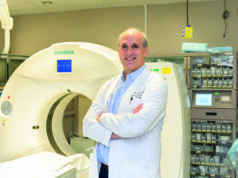
On 11 September, the American Board of Medical Specialties (ABMS) recognised the unique interventional radiology skill set with the new dual certificate in interventional radiology and diagnostic radiology. The Society of Interventional Radiology (SIR) has hailed the affirmation of the specialty’s role in patient care.
The SIR hailed the decision by the ABMS—the organisation that has oversight of the 24 recognised medical specialty boards—to approve the American Board of Radiology’s (ABR’s) application for a new Dual Primary Certificate in Interventional Radiology and Diagnostic Radiology. With this approval, the ABMS and its member boards confirmed the benefit to patients of the unique interventional radiology skill set comprised of competency in diagnostic imaging, image-guided procedures and periprocedural patient care.
The new Dual Certificate in Interventional Radiology and Diagnostic Radiology will be the fourth primary certificate for the ABR and the 37th overall in the United States. A primary certificate is different from a subspecialty certificate as it designates a unique and distinct area of medicine, rather than an area of focus within an existing specialty.
“Support for the Dual Certificate in Interventional Radiology and Diagnostic Radiology by the ABMS is a seminal event in the history of interventional radiology—and one that will benefit future patients by providing well-trained minimally invasive image-guided specialists,” said SIR President Marshall E Hicks, who represents the national society of nearly 5,000 doctors, scientists and allied health professionals dedicated to improving health care through minimally invasive treatments. “The Society of Interventional Radiology applauds ABR for its dedication and hard work in advancing the specialty and the interventional radiology skill set, a unique combination of interpretive and procedural skill, accompanied by corresponding clinical expertise,” said Hicks, the head of the division of diagnostic imaging at the University of Texas MD Anderson Cancer Center, Houston, USA.
“This is an important step in the formalisation of the interventionalist’s clinical role. Recognition of the interventional radiologist’s imaging, technical and periprocedural patient care competencies speaks directly to the specialty’s focus on patients, innovation and advanced image-guided techniques,” said John A Kaufman, a past president of SIR and director of the Dotter Interventional Institute in Portland, USA. “First and foremost, future patients will benefit from this,” said Kaufman, who chaired the SIR/ABR task force that has been developing the certificate since 2005.
“Since the early 20th century, board certification—a form of professional self-regulation—has assured the public of the qualifications of medical professionals,” said Gary J Becker, ABR executive director. “Only rarely does the house of medicine acknowledge the importance of a new primary specialty certificate in fulfilling these responsibilities. The ABR supported the creation of this primary certificate based on the need to ensure that future trainees acquire the requisite combination of clinical, procedural and interpretive skills necessary for the safe and competent practice of interventional radiology. The interventional radiology and diagnostic radiology certificate ensures that board-certified interventional radiologists are trained and qualified to deliver the highest level of care available today, and it demands that this same quality be made available to all future patients,” he added.
“ABR is pleased to offer this new certification and notes its importance to patients, the public and the profession. The addition of the interventional radiology/diagnostic radiology certificate to the other primary certificates offered by the ABR—Diagnostic Radiology, Radiation Oncology and Medical Physics—rounds out a full range of ABR primary certification services in diagnostic, therapeutic and image-guided procedures, as well as periprocedural clinical care,” said ABR President James P Borgstede. “I would like to acknowledge the vision, leadership and commitment to quality patient care of ABR past presidents N Reed Dunnick, and Bruce G Haffty, who helped to guide the application and approval process. Finally, the ABR notes that a very positive and productive collaboration with SIR on this important endeavour made the new certificate possible,” he added.
“The interventional radiology and diagnostic radiology certificate will help ensure that all patients in the country continue to receive high-quality, consistent, diagnostic, procedural and clinical interventional care,” said Jeanne M LaBerge, an ABR trustee and interventional radiologist at the University of California, San Francisco, USA. “The recent approval of the interventional radiology and diagnostic radiology certificate formalises this belief and gives ‘specialty’ status to the field of interventional radiology while maintaining its intimate and necessary relation to diagnostic radiology,” said Matthew A Mauro, an SIR past president and ABR trustee. “The elevation of interventional radiology to a ‘specialty’ level with its own distinct residency programme places interventional radiology/diagnostic radiology on the same level as surgery, paediatrics and internal medicine in the ABMS hierarchy. This ABMS vote is much more than a superficial clerical action—it is one that initiates a formalised enhanced training programme that will benefit patients across the country and serve as a model throughout the world,” added Mauro, professor and chair, department of radiology, University of North Carolina, Chapel Hill, USA.
“Securing the interventional radiology and diagnostic radiology certificate took tremendous effort by many individuals and support from many societies,” said Kaufman.










